Читать книгу Mini Nonya Favourites - Lee Geok Boi - Страница 4
На сайте Литреса книга снята с продажи.
ОглавлениеThe Nonya Kitchen
'Fusion' before the phrase was even coined, Nonya dishes successfully marry Southeast Asian herbs and spices with Chinese ingredients in a cuisine that is the culinary legacy of the Straits Chinese communities of Malaysia, Singapore and Indonesia.
The Straits, or Peranakan, Chinese trace their roots to the 15th century when predominantly male Chinese migrant traders settled in Southeast Asia and married local women. The male offspring of these unions were often repatriated to China for an education before returning to their newly adopted lands. The daughters, on the other hand, remained and were raised by their mothers before being married off within the community to forge important ties between families. In time, a distinct sub-ethnic group evolved with its own language, dress and, of course, kitchen. The men folk became known as 'Baba' and the women 'Nonya', the female term also lending itself to the glorious cuisine that ensued.
Nonya cuisine reflects the cultural mix of the community: from Malay cuisine were adopted ingredients such as belacan, chillies, lemongrass, galangal and turmeric, and, from Chinese cuisine, a fondness for pork and the requisite styles of food preparation. Later still, more ingredients were incorporated into the cuisine from Indian, Thai and Portuguese Eurasian kitchens.
In the past, there was enough wealth and leisure within the community for the women to devote their time to culinary arts and the preparation of elaborate meals. Although the richer Straits Chinese households employed domestic help, which made the grinding of spices, squeezing of coconut milk and pounding of belacan relatively easy, Nonyas of all social classes were not above enjoying a good gossip in the kitchen while preparing the basic ingredients essential to their cuisine.
Today, the food blender replaces the pestle and mortar and grinding stone in many Nonya households. The only exception to this is in the preparation of Sambal Belacan, a highly aromatic condiment that transforms simple fried fish or plain vegetables into something tantalizing— the heady aromas and earthy flavours of freshly pounded Sambal Belacan cannot be recreated by simple blending.
The curries, sambals, soups and braised pork dishes keep well and often have to be left to stand for an hour or so after cooking to allow the flavours to develop. Except in the one-dish noodle meals such as Mee Siam or Laksa, Nonya food is usually served with plain rice and eaten communally as with Chinese food. However, with the exception of soup, which is served individually with a soup spoon, Chinese-style, the traditional way to eat Nonya curries and sambals is Malay-style, by hand.
How to reduce preparation times Although packaged spice pastes have given busy households an approximation of traditional Nonya food, these ready-to-use spice concoctions cannot compare to freshly prepared, homemade spice pastes. To make Nonya food a quick and easy affair, simply prepare a big batch of spice pastes and keep them frozen in ready-to-cook batches—even ground dried red chillies freeze well. Just don't forget to label the boxes clearly to prevent confusion later on.
How to thicken curries To thicken and enrich a curry or sambal without adding to the spiciness, candlenuts are often added. A good substitute is macadamia nuts or raw almonds.
